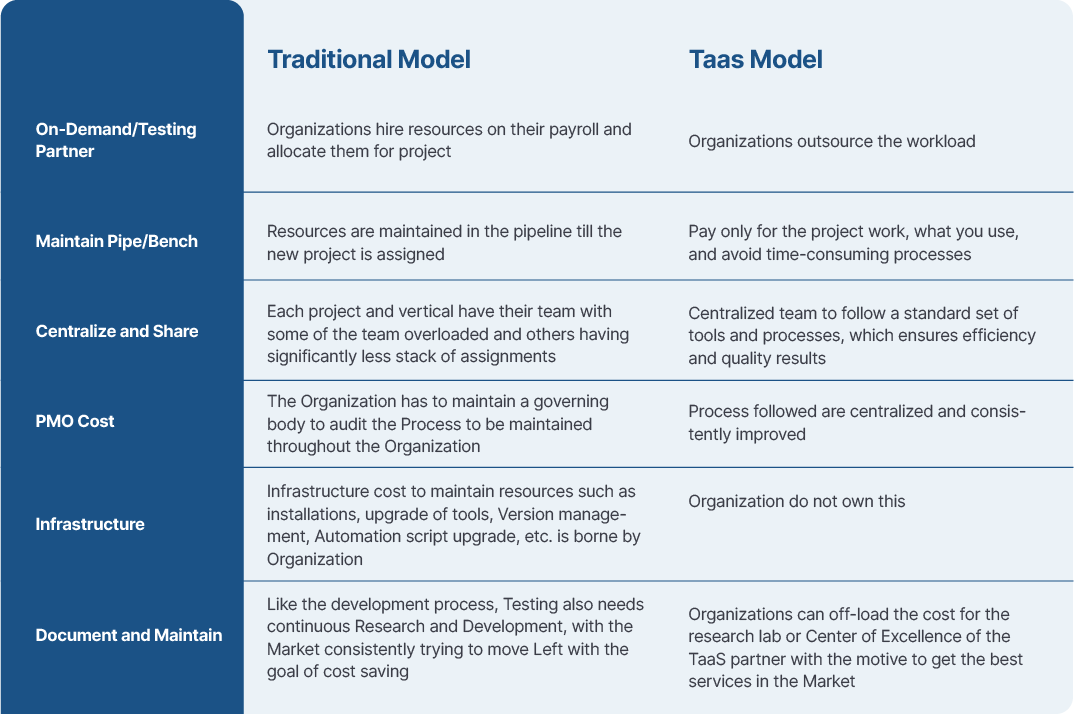In today's dynamic IT landscape, organizations face the challenge of managing numerous initiatives concurrently while dealing with budget constraints. The need for cost optimization becomes paramount, and traditional approaches to Quality Assurance (QA) may not suffice. This is where Software Testing as a Service (TaaS) emerges as a strategic solution to streamline testing processes, enhance efficiency, and reduce costs.
Traditional Model Vs. TaaS Model

Indicators Your Organization Needs Testing as a Service (TaaS)
Organizational Scale and Budget Constraints: TaaS becomes a game-changer when an organization's IT landscape spans across various domains, and the QA budget is either limited or previously nonexistent.
Concurrent Initiatives with Cost Optimization Goals: When multiple initiatives run concurrently, each aiming for cost optimization, TaaS provides a centralized Testing Center of Excellence (CoE) to meet Testing needs efficiently.
Talent Management Challenges: TaaS is the answer when organizations wish to avoid the constant hiring and firing cycle based on market trends, opting for a centralized pool of testing expertise.
Skill Development Needs: For organizations looking to incubate new skills organically, a centralized CoE facilitated by TaaS offers the perfect environment for skill development.
Unused QA Tools: TaaS enables easy access to test labs, infrastructure, and quality management capabilities, reducing the redundancy of unused QA tools.
Major Cases Where Organization Move to TaaS
Case 1
Testing Process Reset: When the existing IT team acknowledges the need for a complete reset, TaaS brings the latest stack and expertise.
Case 2
Optimization and Automation: For organizations halfway through optimization, TaaS provides a solution to overcome existing operational challenges.
Case 3
Vendor Migration Needs: When organizations face challenges with existing TaaS partners considering vendor migration becomes crucial.
Key Gains from Testing as a Service (TaaS)
- Offloading Testing CoE to TaaS: Organizations leverage TaaS to build testing competency, enhance customer satisfaction, and foster a quality culture.
- ROI Measurement: TaaS allows organizations to measure Return on Investment (ROI) for software testing expenses based on Operational Expenditure (Opex) and Capital Expenditure (Capex).
- Integrated Approach: Treating software testing as an integrated set of repeatable activities, TaaS focuses on producing positive business outcomes by building competency in people, processes, and technology.
How to Adopt Testing as a Service Model
Adopting TaaS involves overcoming initial challenges and hurdles. A phased approach ensures a smooth transition:
- Phase 1 - Identifying Major Upcoming Projects: Begin with selecting a team aligned with upcoming projects, allowing for a fresh start without the baggage of existing processes.
- Phase 2 - Optimizing Testing Repositories: Focus on minimizing operational costs by optimizing testing repositories and increasing the automation of User Acceptance Testing (UAT) tools.
- Phase 3- Agile Adoption for Rapid Change: Prioritize needs over wants, adopting an agile approach to address current bugs while keeping an eye on the bigger picture.
The Jade Global Approach: A Proven Methodology for TaaS Implementation
Jade Global, with its extensive experience in implementing Centers of Excellence, emphasizes a systematic three-phase approach:
- Initiation Phase - Building Confidence: Focus on adapting and analyzing to increase delivery confidence by reducing defects found in production, laying the foundation for operational excellence.
- Transformation Phase - Maximizing ROI: Identify reusable components, build regression test beds, and reduce testing costs by leveraging a knowledge base.
- Optimization Phase - Reducing Cycle Time: Concentrate on reducing overall testing cycle time and time to market, using IPs, accelerators, and pre-built standard test cases for continuous improvement.
Conclusion
As the world rapidly adopts cloud technology and services, organizations are recognizing the benefits of Software Testing as a Service in saving costs and improving services. With technology evolving daily, TaaS offers a practical solution to meet the demands for efficient functionality, performance, and scalability. By offloading testing capabilities and infrastructure overheads, organizations can focus on their core products and services, achieving significant savings in both time and cost through TaaS implementation.













